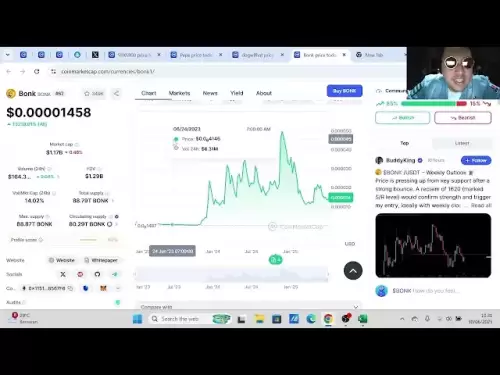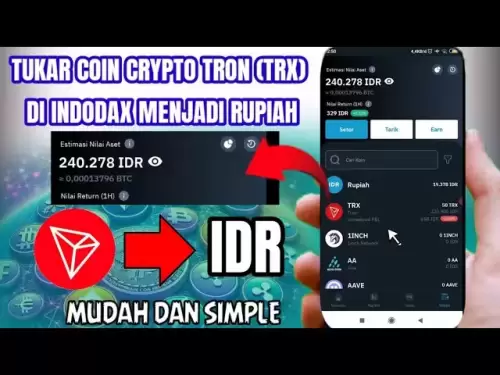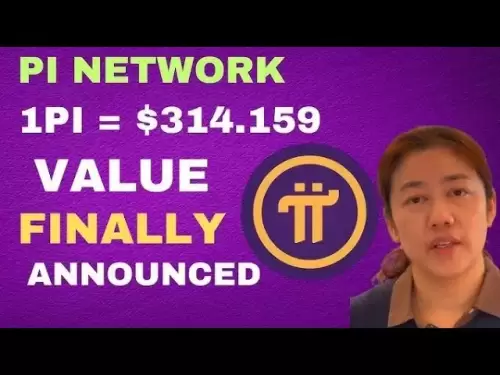-
 Bitcoin
Bitcoin $108,489.6704
1.13% -
 Ethereum
Ethereum $2,502.0528
2.92% -
 Tether USDt
Tether USDt $1.0002
0.00% -
 XRP
XRP $2.1941
0.51% -
 BNB
BNB $655.3375
1.00% -
 Solana
Solana $151.5977
1.27% -
 USDC
USDC $0.9999
0.00% -
 TRON
TRON $0.2768
0.32% -
 Dogecoin
Dogecoin $0.1676
2.86% -
 Cardano
Cardano $0.5675
0.98% -
 Hyperliquid
Hyperliquid $40.6109
7.48% -
 Bitcoin Cash
Bitcoin Cash $500.7746
2.09% -
 Sui
Sui $2.8328
2.03% -
 Chainlink
Chainlink $13.4452
1.26% -
 UNUS SED LEO
UNUS SED LEO $9.1623
0.39% -
 Avalanche
Avalanche $18.2267
2.24% -
 Stellar
Stellar $0.2382
0.00% -
 Toncoin
Toncoin $2.8885
1.68% -
 Shiba Inu
Shiba Inu $0.0...01159
0.91% -
 Litecoin
Litecoin $87.1827
0.88% -
 Hedera
Hedera $0.1511
2.90% -
 Monero
Monero $315.4992
-0.59% -
 Polkadot
Polkadot $3.4663
2.34% -
 Bitget Token
Bitget Token $4.6118
-0.65% -
 Dai
Dai $1.0000
-0.01% -
 Ethena USDe
Ethena USDe $1.0003
0.02% -
 Uniswap
Uniswap $7.2989
4.69% -
 Pepe
Pepe $0.0...01003
5.73% -
 Aave
Aave $275.5616
7.15% -
 Pi
Pi $0.5181
-2.49%
How to trade EOS on OKEx? Beginner's guide
To trade EOS on OKEx, set up an account, complete KYC, deposit funds, and use market or limit orders to buy or sell EOS, while ensuring account security with 2FA.
Apr 04, 2025 at 09:36 am
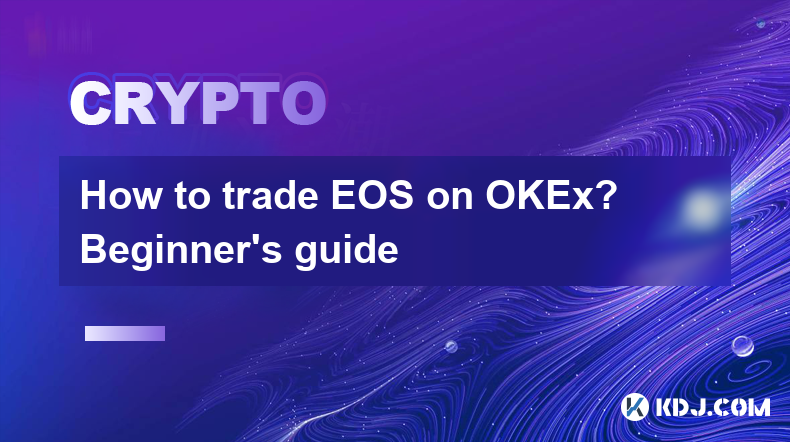
Trading EOS on OKEx can be an exciting venture for beginners eager to dive into the world of cryptocurrency. To get started, you'll need to understand the basics of trading, familiarize yourself with OKEx's platform, and learn how to manage your investments effectively. This beginner's guide will walk you through the steps to trade EOS on OKEx, from setting up your account to executing your first trade. We'll cover essential concepts, safety tips, and strategies to help you navigate the market confidently.
Setting Up Your OKEx Account
Before you can start trading EOS on OKEx, you need to create an account. Visit the OKEx website and click on the "Sign Up" button. You'll be prompted to enter your email address and create a strong password. Make sure to choose a password that includes a mix of letters, numbers, and symbols to enhance security. After submitting your details, you'll receive a verification email. Click on the link in the email to activate your account.
Once your account is activated, you'll need to complete the KYC (Know Your Customer) verification process. This involves submitting a copy of your government-issued ID and a selfie. OKEx requires this to comply with regulatory standards and to protect users from fraud. The verification process may take a few hours to a few days, depending on the volume of applications.
After your KYC verification is approved, you can log into your OKEx account and start exploring the platform. Take some time to familiarize yourself with the layout and features. You can access various trading tools, market data, and educational resources to enhance your trading knowledge.
Depositing Funds into Your OKEx Account
To trade EOS, you'll need to deposit funds into your OKEx account. Navigate to the "Funds" section and select "Deposit." Choose the cryptocurrency you want to deposit, such as Bitcoin or Ethereum, and follow the instructions to generate a deposit address. Copy the address and use it to send funds from your external wallet to your OKEx account.
It's crucial to double-check the deposit address before sending any funds. A single mistake could result in the loss of your cryptocurrency. Once you've sent the funds, it may take some time for the transaction to be confirmed on the blockchain. You can monitor the status of your deposit in the "Deposit History" section of your OKEx account.
After your deposit is confirmed, the funds will be available in your OKEx account. You can then use these funds to purchase EOS or other cryptocurrencies. OKEx supports a wide range of trading pairs, so you can choose the one that best suits your trading strategy.
Understanding EOS and Its Trading Pairs
EOS is a blockchain platform designed to support the development of decentralized applications (dApps). It uses a delegated proof-of-stake (DPoS) consensus mechanism, which allows token holders to vote for block producers. EOS tokens are used to pay for transaction fees and resource usage on the network.
On OKEx, you can trade EOS against various cryptocurrencies, such as Bitcoin (BTC), Ethereum (ETH), and USDT (Tether). Each trading pair represents a market where you can buy or sell EOS. For example, the EOS/BTC trading pair allows you to exchange EOS for Bitcoin, while the EOS/USDT pair lets you trade EOS for USDT, a stablecoin pegged to the US dollar.
Before you start trading, it's essential to understand the dynamics of each trading pair. Factors such as liquidity, volatility, and trading volume can impact your trading experience. You can access detailed market data and charts on OKEx to analyze the performance of different trading pairs and make informed decisions.
Placing Your First EOS Trade on OKEx
Now that you have funds in your OKEx account and understand the basics of EOS and its trading pairs, you're ready to place your first trade. Navigate to the "Trade" section of the OKEx platform and select the EOS trading pair you want to use. For this example, let's assume you're trading EOS/USDT.
You'll see a trading interface with various order types, including market orders, limit orders, and stop-loss orders. A market order allows you to buy or sell EOS at the current market price. A limit order lets you set a specific price at which you want to buy or sell EOS. A stop-loss order is used to limit potential losses by automatically selling EOS if the price drops to a certain level.
To place a market order, enter the amount of EOS you want to buy or sell and click on the "Buy" or "Sell" button. The trade will be executed immediately at the best available price. For a limit order, enter the amount of EOS and the desired price, then click on the "Buy" or "Sell" button. The order will be added to the order book and executed when the market reaches your specified price.
Managing Your EOS Trades and Portfolio
After placing your first trade, it's important to monitor your positions and manage your portfolio effectively. OKEx provides various tools to help you track your trades and analyze market trends. You can access your trade history, open orders, and account balance in the "Orders" and "Funds" sections of the platform.
To manage your EOS trades, you can set up price alerts to notify you when the market reaches certain levels. You can also use stop-loss orders to protect your investments from significant losses. If the price of EOS drops to your specified stop-loss level, the order will be automatically executed, limiting your potential losses.
Diversifying your portfolio is another key strategy for managing your EOS trades. Instead of investing all your funds in EOS, consider allocating a portion of your capital to other cryptocurrencies. This can help spread risk and potentially increase your overall returns. OKEx offers a wide range of cryptocurrencies, making it easy to diversify your portfolio.
Advanced Trading Strategies for EOS on OKEx
As you gain more experience trading EOS on OKEx, you can explore advanced trading strategies to enhance your performance. One popular strategy is dollar-cost averaging (DCA), which involves investing a fixed amount of money at regular intervals, regardless of the market price. This can help reduce the impact of volatility and potentially lower your average cost per EOS token.
Another strategy is swing trading, which involves holding EOS for a short to medium-term period to capitalize on price swings. Swing traders use technical analysis to identify entry and exit points, aiming to profit from short-term market movements. OKEx provides various charting tools and indicators to help you analyze market trends and make informed trading decisions.
For more experienced traders, arbitrage can be an effective strategy. Arbitrage involves buying EOS on one exchange and selling it on another at a higher price, profiting from the price difference. OKEx's competitive fees and liquidity make it an attractive platform for arbitrage trading. However, arbitrage requires careful monitoring of market conditions and quick execution to be profitable.
Ensuring Security and Safety on OKEx
Security is paramount when trading EOS on OKEx. To protect your account and funds, enable two-factor authentication (2FA) as an additional layer of security. OKEx supports 2FA through apps like Google Authenticator or Authy. This adds an extra step to the login process, making it more difficult for unauthorized users to access your account.
Another important security measure is to use a strong and unique password for your OKEx account. Avoid using easily guessable passwords and never share your login credentials with anyone. Additionally, be cautious of phishing attempts, which are fraudulent attempts to steal your personal information. Always verify the authenticity of emails and websites before entering any sensitive data.
To further enhance security, consider using a hardware wallet to store your EOS tokens. Hardware wallets are physical devices that store your private keys offline, making them less vulnerable to hacking. You can transfer your EOS tokens from OKEx to your hardware wallet for long-term storage and move them back to OKEx when you want to trade.
Common Questions About Trading EOS on OKEx
Q: What is the minimum amount of EOS I can trade on OKEx?
A: The minimum trade amount for EOS on OKEx varies depending on the trading pair. For example, the minimum order size for the EOS/USDT pair is typically 0.01 EOS. You can check the specific minimum trade amounts for each pair on the OKEx platform.
Q: How long does it take to deposit and withdraw EOS on OKEx?
A: The time it takes to deposit and withdraw EOS on OKEx depends on the blockchain network's congestion. Deposits usually take a few minutes to an hour to be confirmed, while withdrawals can take anywhere from a few minutes to several hours. You can monitor the status of your transactions in the "Deposit History" and "Withdrawal History" sections of your OKEx account.
Q: Can I trade EOS on OKEx using a mobile app?
A: Yes, OKEx offers a mobile app for both iOS and Android devices. You can download the app from the App Store or Google Play Store and use it to trade EOS on the go. The mobile app provides a user-friendly interface and access to all the features available on the OKEx website.
Q: What are the trading fees for EOS on OKEx?
A: OKEx charges trading fees based on your trading volume and account tier. The standard fee for EOS trading is 0.1% for makers and 0.15% for takers. However, you can reduce your fees by increasing your trading volume or holding OKB, OKEx's native token. You can find detailed information about trading fees on the OKEx website.
Q: Is it safe to trade EOS on OKEx?
A: OKEx takes several measures to ensure the safety and security of its users. The platform uses advanced encryption technology to protect user data and funds. Additionally, OKEx has a robust risk management system and complies with regulatory standards. However, it's essential to take personal security measures, such as enabling 2FA and using strong passwords, to further protect your account.
Disclaimer:info@kdj.com
The information provided is not trading advice. kdj.com does not assume any responsibility for any investments made based on the information provided in this article. Cryptocurrencies are highly volatile and it is highly recommended that you invest with caution after thorough research!
If you believe that the content used on this website infringes your copyright, please contact us immediately (info@kdj.com) and we will delete it promptly.
- Ripple XRP, Bitcoin, and Solaris Presale: What's the Buzz?
- 2025-06-30 18:50:11
- SpaceX, Mirror Tokens, and Investors: A Wild Ride to the Future?
- 2025-06-30 19:10:22
- Arbitrum (ARB) and Robinhood: Partnership Rumors Fuel Price Surge to $0.4289?
- 2025-06-30 19:10:22
- Jasmy Coin, Bitcoin, and the Rise of Solaris Presale: What's the Buzz?
- 2025-06-30 18:30:12
- XRP, SEC, and Ripple: A New Chapter?
- 2025-06-30 19:15:13
- Arbitrum's ARB Price Surges Amid Robinhood Partnership Buzz: A New York Minute on Crypto
- 2025-06-30 19:30:12
Related knowledge
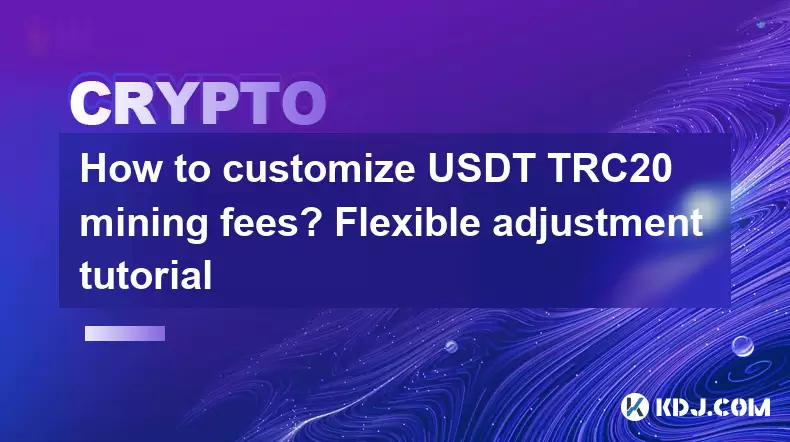
How to customize USDT TRC20 mining fees? Flexible adjustment tutorial
Jun 13,2025 at 01:42am
Understanding USDT TRC20 Mining FeesMining fees on the TRON (TRC20) network are essential for processing transactions. Unlike Bitcoin or Ethereum, where miners directly validate transactions, TRON uses a delegated proof-of-stake (DPoS) mechanism. However, users still need to pay bandwidth and energy fees, which are collectively referred to as 'mining fe...
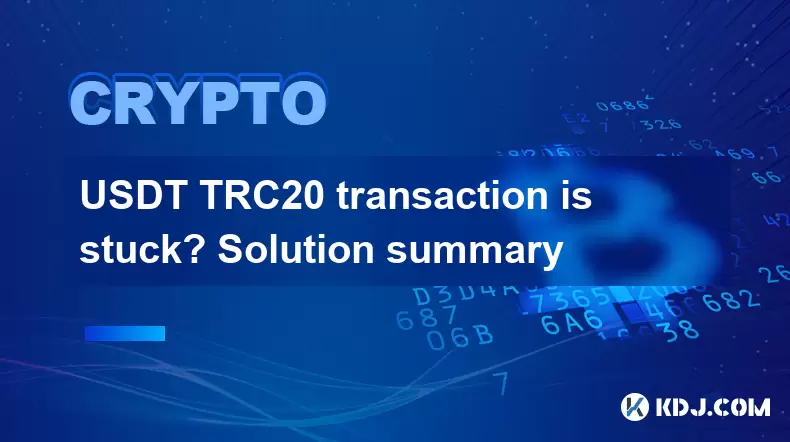
USDT TRC20 transaction is stuck? Solution summary
Jun 14,2025 at 11:15pm
Understanding USDT TRC20 TransactionsWhen users mention that a USDT TRC20 transaction is stuck, they typically refer to a situation where the transfer of Tether (USDT) on the TRON blockchain has not been confirmed for an extended period. This issue may arise due to various reasons such as network congestion, insufficient transaction fees, or wallet-rela...
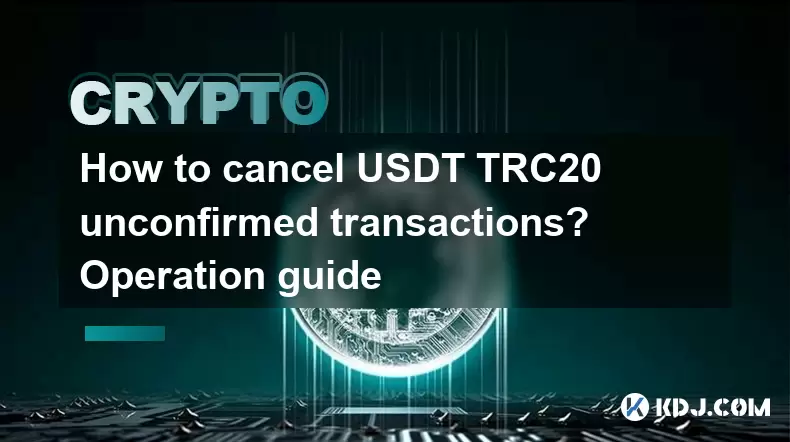
How to cancel USDT TRC20 unconfirmed transactions? Operation guide
Jun 13,2025 at 11:01pm
Understanding USDT TRC20 Unconfirmed TransactionsWhen dealing with USDT TRC20 transactions, it’s crucial to understand what an unconfirmed transaction means. An unconfirmed transaction is one that has been broadcasted to the blockchain network but hasn’t yet been included in a block. This typically occurs due to low transaction fees or network congestio...
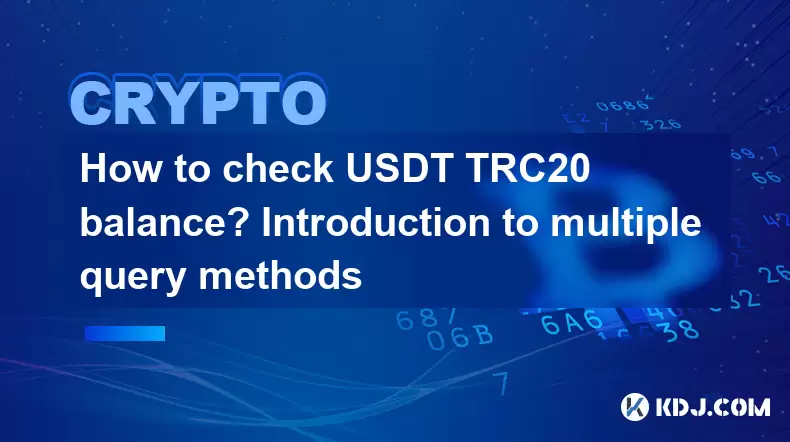
How to check USDT TRC20 balance? Introduction to multiple query methods
Jun 21,2025 at 02:42am
Understanding USDT TRC20 and Its ImportanceUSDT (Tether) is one of the most widely used stablecoins in the cryptocurrency market. It exists on multiple blockchain networks, including TRC20, which operates on the Tron (TRX) network. Checking your USDT TRC20 balance accurately is crucial for users who hold or transact with this asset. Whether you're sendi...
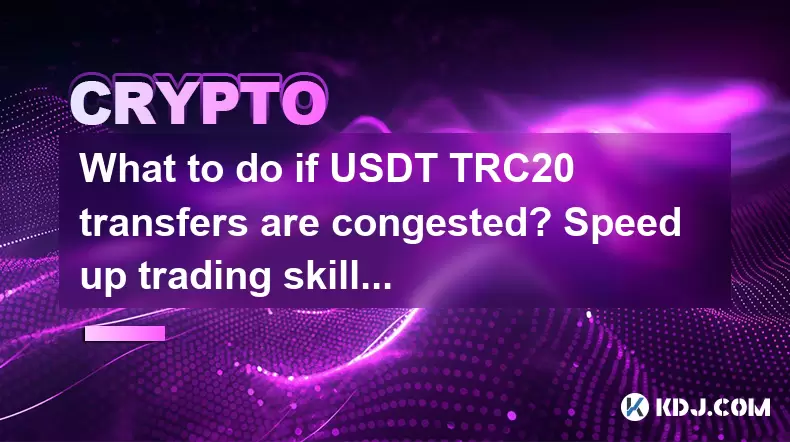
What to do if USDT TRC20 transfers are congested? Speed up trading skills
Jun 13,2025 at 09:56am
Understanding USDT TRC20 Transfer CongestionWhen transferring USDT TRC20, users may occasionally experience delays or congestion. This typically occurs due to network overload on the TRON blockchain, which hosts the TRC20 version of Tether. Unlike the ERC20 variant (which runs on Ethereum), TRC20 transactions are generally faster and cheaper, but during...
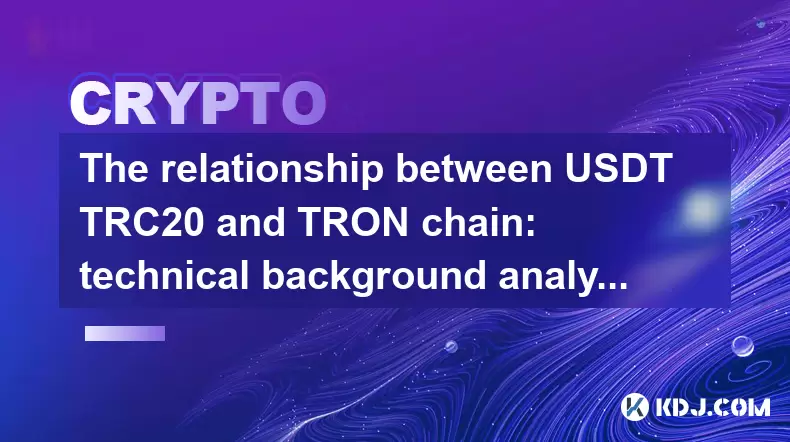
The relationship between USDT TRC20 and TRON chain: technical background analysis
Jun 12,2025 at 01:28pm
What is USDT TRC20?USDT TRC20 refers to the Tether (USDT) token issued on the TRON blockchain using the TRC-20 standard. Unlike the more commonly known ERC-20 version of USDT (which runs on Ethereum), the TRC-20 variant leverages the TRON network's infrastructure for faster and cheaper transactions. The emergence of this version came as part of Tether’s...

How to customize USDT TRC20 mining fees? Flexible adjustment tutorial
Jun 13,2025 at 01:42am
Understanding USDT TRC20 Mining FeesMining fees on the TRON (TRC20) network are essential for processing transactions. Unlike Bitcoin or Ethereum, where miners directly validate transactions, TRON uses a delegated proof-of-stake (DPoS) mechanism. However, users still need to pay bandwidth and energy fees, which are collectively referred to as 'mining fe...

USDT TRC20 transaction is stuck? Solution summary
Jun 14,2025 at 11:15pm
Understanding USDT TRC20 TransactionsWhen users mention that a USDT TRC20 transaction is stuck, they typically refer to a situation where the transfer of Tether (USDT) on the TRON blockchain has not been confirmed for an extended period. This issue may arise due to various reasons such as network congestion, insufficient transaction fees, or wallet-rela...

How to cancel USDT TRC20 unconfirmed transactions? Operation guide
Jun 13,2025 at 11:01pm
Understanding USDT TRC20 Unconfirmed TransactionsWhen dealing with USDT TRC20 transactions, it’s crucial to understand what an unconfirmed transaction means. An unconfirmed transaction is one that has been broadcasted to the blockchain network but hasn’t yet been included in a block. This typically occurs due to low transaction fees or network congestio...

How to check USDT TRC20 balance? Introduction to multiple query methods
Jun 21,2025 at 02:42am
Understanding USDT TRC20 and Its ImportanceUSDT (Tether) is one of the most widely used stablecoins in the cryptocurrency market. It exists on multiple blockchain networks, including TRC20, which operates on the Tron (TRX) network. Checking your USDT TRC20 balance accurately is crucial for users who hold or transact with this asset. Whether you're sendi...

What to do if USDT TRC20 transfers are congested? Speed up trading skills
Jun 13,2025 at 09:56am
Understanding USDT TRC20 Transfer CongestionWhen transferring USDT TRC20, users may occasionally experience delays or congestion. This typically occurs due to network overload on the TRON blockchain, which hosts the TRC20 version of Tether. Unlike the ERC20 variant (which runs on Ethereum), TRC20 transactions are generally faster and cheaper, but during...

The relationship between USDT TRC20 and TRON chain: technical background analysis
Jun 12,2025 at 01:28pm
What is USDT TRC20?USDT TRC20 refers to the Tether (USDT) token issued on the TRON blockchain using the TRC-20 standard. Unlike the more commonly known ERC-20 version of USDT (which runs on Ethereum), the TRC-20 variant leverages the TRON network's infrastructure for faster and cheaper transactions. The emergence of this version came as part of Tether’s...
See all articles























